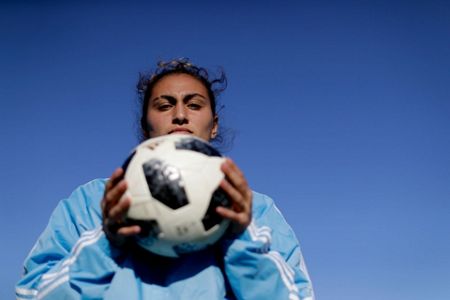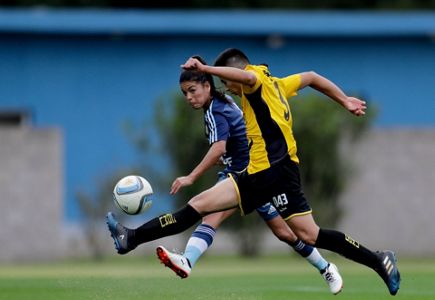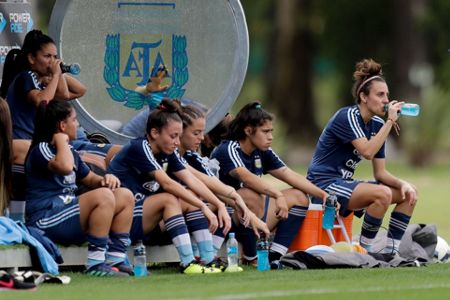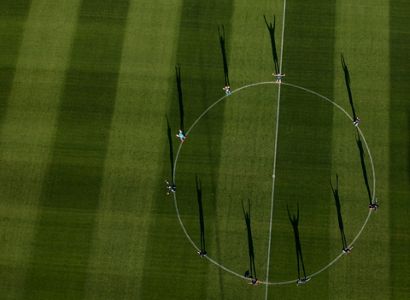BUENOS AIRES, Argentina (AP) — In a country where the soccer conversation is overwhelmingly dominated by talk of Lionel Messi and Diego Maradona, female players in Argentina struggle to be heard.
That's changing rapidly, however, and it's partly because of a picture that was widely shared on social media.
The photo, taken in April before a Women's Copa America match in Chile, showed the Argentine players with their hands cupped behind their right ears, a sign of protest highlighting that no one was listening to them. It took social media to spread the message because the traditional media, including Argentina's top TV channels and newspapers, didn't even cover the continental championship.
"We live in a soccer-mad country but with a lot of machismo," Argentina forward Belen Potassa said at the national team's training grounds on the outskirts of Buenos Aires. "Soccer is Messi, (Gonzalo) Higuain, (Diego) Maradona and no one else."
While those players are adored and even idolized, the women's team has been sidelined — just like in other countries around the world.
The Argentine soccer federation often is late in paying travel expenses while the players have routinely faced the prejudices of a chauvinistic society that sees soccer as a men's only game. Still, the long-disadvantaged team of women may be on the verge of a game changer by defying long-established gender inequalities and proving themselves on and off the field.
By finishing third at the Copa America, the team in the light blue-and-white striped shirts earned a place in the playoffs for this year's Women's World Cup in France. Argentina will play Panama on Thursday for a spot in the 24-team tournament. For the first time in the country's women's soccer history, the game will be played at a sold out stadium in Buenos Aires.
Another major achievement came in practice.
The women's team was recently allowed to train at the same complex where Messi and the rest of the men's team prepare for games, grounds that until recently were reserved for men only.
"Women fight since they're born because we don't have the same rights as men. But in sports the sacrifice is twice as tough. They don't pay you, the clothes are not the same, the sponsors are not the same," said Potassa, who recently signed a contract with a well-known sports brand that supplies her with boots and clothing.
The women's team's progress has even received the support of Messi and several Argentine professional clubs that have promoted the playoff game against Panama on social media under the motto: "It's time to root for them."
Many female players say they feel part of a cultural change driven by the country's strong feminist movement, which has mobilized tens of thousands to fight against violence against women, and helped them gain ground in politics and the workplace.
But to gain equality, there is still a long way to go.
While the men's league draws huge crowds and brings in millions of dollars, female players are amateurs and get about 3,000 pesos (about $82) for travel expenses at a first division club. If a woman plays for the national team, she'll earn 300 pesos ($8) a day.
That forces players to split their time between soccer and a second job to survive, said Potassa, who is also a receptionist at a local college.
Veteran goalkeeper Vanina Correa, the only mother in the national team, said the hardest part is being away from her children, Romeo and Luna. The 4-year-old twins stay with their grandmother while Correa trains for the playoff more than 185 miles (300 kilometers) from home.
"It's very hard to be here," said Correa, who doubles as a municipal employee. "I'm always thinking about home and wondering what they're doing and if they're behaving.
"It would be more comfortable if we could live off soccer. I don't have much left (in my career) but we're fighting for the girls who are coming next."
That fight has been going on all over the world.
Ahead of the last Women's World Cup in 2015, a group of international players protested because the tournament was scheduled to be played on artificial turf, which is considered by many to be inferior to the real grass that has always been used in the men's game.
The tournament in Canada went on to be a huge success: It attracted the biggest crowds of any FIFA tournament outside of a men's World Cup and broke TV rating records in North America, with the final drawing more viewers than any other prior men's or women's match in the United States.
Following their victory over Japan for the trophy, the U.S. women went on to campaign for, and receive, a better contract with U.S. Soccer that brought them closer to the compensation level of their male counterparts. The Americans were not alone. National teams from other countries also won more equitable contracts with their federations, including Australia and Ireland.
But in Argentina, that kind of change still seems far away and female soccer players must join leagues in neighboring Brazil, Europe or the United States to make a living from the sport.
One of the major obstacles they face is the lack of attention. It wasn't until this year that a non-sports TV channel finally began broadcasting league games.
"Women are not accepted in this environment yet. That's why there's so much resistance to broadcasting female sports, especially soccer," said 19-year-old wingback Luana Munoz, who also plays for Tyler Junior College in Texas. "It has to be promoted, people need to know that it is being played, they need to know the name of the players, and the tournament has to be competitive."
Internationally, FIFA has made a point of proclaiming that it aims to raise both the role of women in the governing body and the profile of the women's game. Fatma Samoura was appointed the organization's first female secretary general in 2016, and a women's soccer division was created.
In Argentina, the development taking place in local women's soccer is a recent phenomenon.
"When we asked our youngest daughter what sport she wanted to practice, she said soccer. She ended up playing hockey," said Ricardo Pinela, president of the Argentine federation's women's soccer committee. "The first step is that the girls have the possibility to kick a ball in front of their house. This will generate the development of female soccer and we will see equality in the number of men and women playing the game."
The inequality faced by the Argentines is seen in countries throughout South America, including Chile, which has already qualified for the World Cup. The only exception perhaps is Brazil, where six-time world player of the year Marta has given the women's game a platform for success.
"(Men's) professional clubs don't carry the responsibility or care about granting the girls the most basic work conditions," said Freddy Contreras, who is in charge of the female team at Colo Colo, the most popular club in Chile.
Contreras said clubs don't lend women fields for training and only supply them with one set of shirts.
The Argentine women's team only was given access to the men's training ground after its poor working conditions became publicly known.
"These are things that we didn't have before," Munoz said. "It doesn't give us the same status but it gets us close. We're being given the same place as the professionals. That's very important to us, even if it's small, even if it's a detail."
___
Associated Press writer Eva Vergara in Santiago, Chile, and AP Sports Writer Anne M. Peterson in Portland, Oregon, contributed to this report.
___
More AP soccer: https://apnews.com/apf-Soccer and https://twitter.com/AP_Sports
Copyright 2018 The Associated Press. All rights reserved. This material may not be published, broadcast, rewritten or redistributed.













